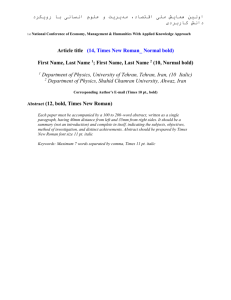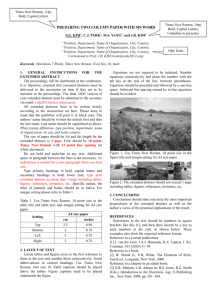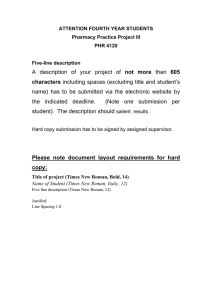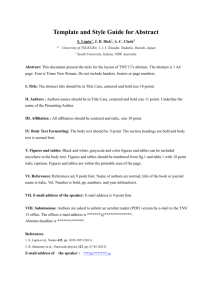6th RCCE Full paper format.doc
advertisement
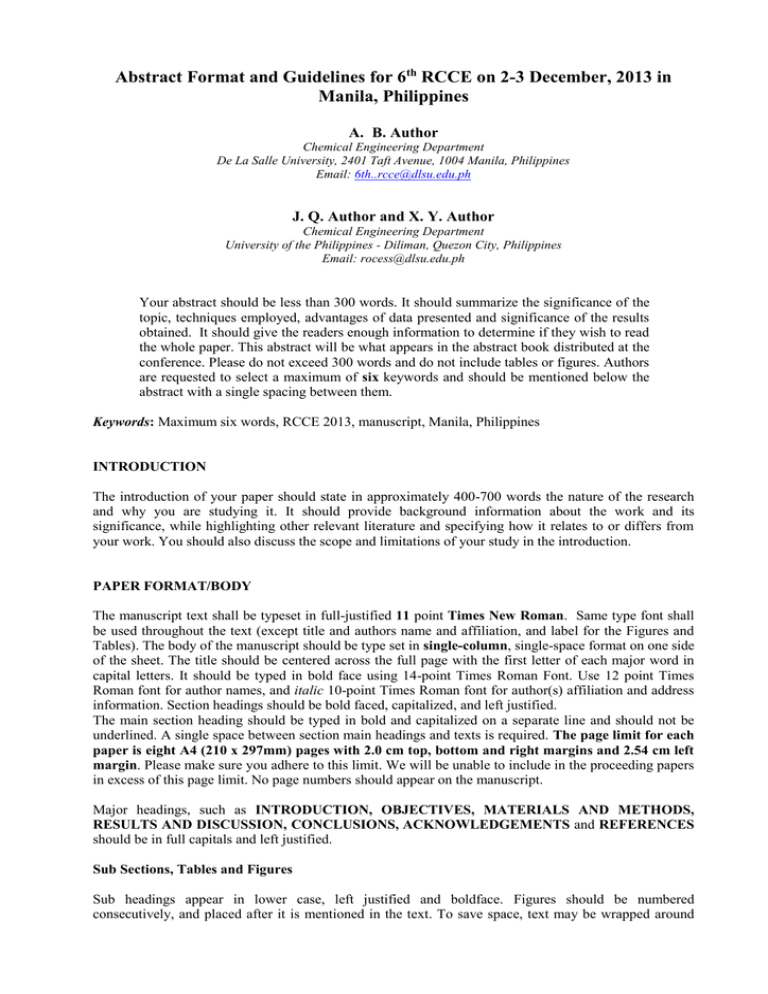
Abstract Format and Guidelines for 6th RCCE on 2-3 December, 2013 in Manila, Philippines A. B. Author Chemical Engineering Department De La Salle University, 2401 Taft Avenue, 1004 Manila, Philippines Email: 6th..rcce@dlsu.edu.ph J. Q. Author and X. Y. Author Chemical Engineering Department University of the Philippines - Diliman, Quezon City, Philippines Email: rocess@dlsu.edu.ph Your abstract should be less than 300 words. It should summarize the significance of the topic, techniques employed, advantages of data presented and significance of the results obtained. It should give the readers enough information to determine if they wish to read the whole paper. This abstract will be what appears in the abstract book distributed at the conference. Please do not exceed 300 words and do not include tables or figures. Authors are requested to select a maximum of six keywords and should be mentioned below the abstract with a single spacing between them. Keywords: Maximum six words, RCCE 2013, manuscript, Manila, Philippines INTRODUCTION The introduction of your paper should state in approximately 400-700 words the nature of the research and why you are studying it. It should provide background information about the work and its significance, while highlighting other relevant literature and specifying how it relates to or differs from your work. You should also discuss the scope and limitations of your study in the introduction. PAPER FORMAT/BODY The manuscript text shall be typeset in full-justified 11 point Times New Roman. Same type font shall be used throughout the text (except title and authors name and affiliation, and label for the Figures and Tables). The body of the manuscript should be type set in single-column, single-space format on one side of the sheet. The title should be centered across the full page with the first letter of each major word in capital letters. It should be typed in bold face using 14-point Times Roman Font. Use 12 point Times Roman font for author names, and italic 10-point Times Roman font for author(s) affiliation and address information. Section headings should be bold faced, capitalized, and left justified. The main section heading should be typed in bold and capitalized on a separate line and should not be underlined. A single space between section main headings and texts is required. The page limit for each paper is eight A4 (210 x 297mm) pages with 2.0 cm top, bottom and right margins and 2.54 cm left margin. Please make sure you adhere to this limit. We will be unable to include in the proceeding papers in excess of this page limit. No page numbers should appear on the manuscript. Major headings, such as INTRODUCTION, OBJECTIVES, MATERIALS AND METHODS, RESULTS AND DISCUSSION, CONCLUSIONS, ACKNOWLEDGEMENTS and REFERENCES should be in full capitals and left justified. Sub Sections, Tables and Figures Sub headings appear in lower case, left justified and boldface. Figures should be numbered consecutively, and placed after it is mentioned in the text. To save space, text may be wrapped around Figures and Tables. However, the Figure or Table should be flush against either the left or right margin such that text only wraps around one side. The same applies to tables as shown in Table 1. Figure captions should be centered below the illustrations as shown in Fig. 1. The figure labels shall be typeset in 9 points Times New Roman. Units of Measurements The use of S.I. units (Systeme Internationale d’Unites) in papers is mandatory. Table 1 Fonts for Camera-Ready Papers Text Paper’s Title Author’s Name/s Affiliations and address Section titles Abstract Body of the text Subheadings Label for Figures and Tables Font Size 14 pt 12 pt 10 pt Style Type Bold Bold Italic Lowercase Lowercase Lowercase 11 pt 11 pt 11 pt 11 pt 10 pt Bold Normal Normal Bold Bold CAPITAL Lowercase Lowercase Lowercase Lowercase Photographs and Equations Figures and photographs should be sharp, high contrast and black and white glossy prints only. Equations shall be centered. The equations shall also be numbered and their respective number shall be given in parentheses and aligned flush with right hand margin. A single spacing should be used between text, following figures and their titles. CONCLUSIONS This section should highlight key findings and compare the results of your work to others as appropriate. Conclusions should be based on the evidence in your paper. Discuss how your work contributes to other studies. ACKNOWLEDGMENTS Figure 1. Example of Figure If your paper contains acknowledgments, they should be placed after the conclusion but before the references. REFERENCES Provide a list of references at the end of the paper. Footnotes should be avoided. The reference section should follow immediately after the acknowledgement section. Your references to published literature should be quoted in the text by authors last name and year (use both authors’ last names if two, first author and et. al. when more than two). References should be listed at the end of the paper in alphabetical order, based on author’s patentee’s, or editors last name. Your references can include italic and/or boldface type as appropriate. Examples of reference formatting are given here. Mernyk W. M., (1965). The Elements of Input Output Analysis. Random House, New York. Mullen E. J., R. Chazin and D. M. Feldstein, (1972). Services for the newly dependent. The Social Serv. Rev. 46, 309-322. C. Tanford, (1991). Physical Chemistry of macromolecules, Wiley, New York. Lewin, D. R. and Lavie, T., (1990). Designing and implementing trajectories in an exothermic batch chemical reactor. Ind. Chem. Engng Proc. Dev. 29, 89. Geactinov, N.E., (1985). In Polycyclic Hydrocarbons and Carcinogenesis; Harvey, R.G., Ed.; ACS Symposium Series 283; American Chemical Society: Washington, D.C., pp 12-45. Norman, L.O., (1983). U.S. Patent 4 379 752. Hussain, M. A., (1996). Inverse Model Control Strategies Using Neural Networks: Analysis, simulation and on-line implementation, Ph.D. Thesis (University of London). Sherma, J. and Beroza, M., (1979). Manual of Analytical Quality Control for Pesticides and Related Compounds; U.S. Environmental Protection Agency. U.S. Government Printing Office: Washington, D.C. EPA-600/1-79/008. PAPER SUBMISSION Please make sure you have followed the proposed paper format. The deadline for submission is on October 15, 2013. Email: 6th.rcce@gmail.com. If you do not adhere to the formatting instructions in this style guide, your submission may not be published in the conference proceedings in any form. If your paper is not received by the closing date, it will be classified as an unreviewed article. Thank you for your co-operation and contributions. We look forward to receiving your papers.

